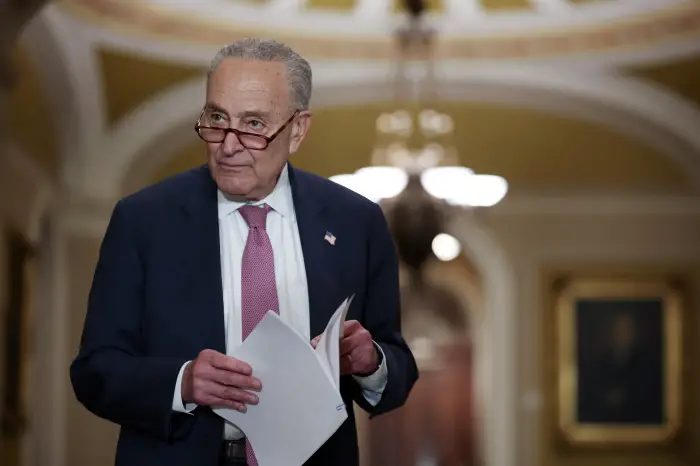The lights are still on inside the U.S. Capitol — but for millions of federal workers, the power is already fading.
For the fourth time in two weeks, the United States Senate failed to approve a temporary funding bill to reopen the government, deepening a political standoff that now threatens to stretch into October.
On Friday afternoon, senators filed in, voted, and filed back out again.
The result was depressingly familiar: 54 votes in favor, 44 against — six shy of the 60 needed to break the filibuster.
The clock ticked past 3 p.m., the vote was gaveled closed, and the “Schumer Shutdown”, as Republicans are now branding it, officially rolled into another weekend.
The Vote That Changed Nothing
In the cavernous chamber of the United States Senate, the vote tally flickered briefly on the screen.
A handful of Democrats — Catherine Cortez Masto (Nevada), John Fetterman (Pennsylvania), and Independent Angus King (Maine) — crossed party lines to support the GOP-backed funding bill.
But it wasn’t enough.
The final count fell short of the magic number: sixty.
And with that, Washington slipped further into crisis.
“This isn’t complicated,” sighed one weary Senate staffer as members streamed toward waiting cars. “The House did its job. The White House supports the bill. The only thing holding this up is Schumer.”
The White House Blames Democrats
From the West Wing, the frustration was palpable.
In a sharply worded post on X, the White House accused Senate Democrats of “voting to keep the government closed to give free healthcare to illegal aliens.”
“SHAME ON THEM,” the statement declared — echoing the blunt, combative tone that has defined President Donald Trump’s second administration.
Trump himself had warned earlier in the week that Democrats were using the shutdown as political leverage.
“They want chaos, not compromise,” he told a crowd in Harrisburg, Pennsylvania. “But what they don’t understand is — the American people are tired of chaos. They’re tired of politicians who put illegal aliens before American citizens.”
The president’s aides, meanwhile, were quick to emphasize that the administration has already taken steps to cut costs and reduce the national debt while Congress drags its feet.
Just hours before the vote, Trump’s team announced $8 billion in cuts to renewable energy programs — all of them located in Democratic strongholds like California and New York.
The message was clear: if Democrats won’t agree to fund the government, Trump will tighten the belt himself.
A Shutdown Measured in Human Terms
Outside the Beltway, the consequences of congressional inaction are beginning to sink in.
At a post office in Arlington, Virginia, clerks were handed furlough notices.
At the U.S. Department of Agriculture, workers were told to expect “indefinite suspension.”
Across the country, 800,000 federal employees now face unpaid weekends — and possibly weeks — as the stalemate drags on.
Air traffic controllers are still working. TSA officers are still screening passengers. But morale is cracking.
“People are scared,” said an FAA technician at Dulles International Airport, requesting anonymity. “We went through this in 2019. We didn’t think we’d see it again.”
Markets have held steady so far, but analysts warn that continued gridlock could startle investors and slow the fragile economic recovery.
“This is not a financial crisis — yet,” said Sarah Reynolds, a senior economist at the Brookings Institution. “But the longer this lasts, the more damage it will do to consumer confidence and the broader economy. Government shutdowns are expensive. The last one cost more than $11 billion.”
Inside the Senate: A Battle of Narratives
Friday’s vote was about more than a spending bill. It was about political messaging — and which party the public will blame.
To Senate Minority Leader Chuck Schumer (D-N.Y.), this was a matter of principle.
“Republicans are trying to bludgeon us into gutting healthcare protections,” he said after the vote. “We won’t allow that. We will not let them hold the government hostage just to hurt the most vulnerable.”
To Senate Majority Leader John Thune (R-S.D.), it was the exact opposite.
“Democrats are shutting down the government to give free healthcare to illegal immigrants,” Thune told reporters. “That’s the story. That’s the truth.”
The gulf between those two versions of reality could not be wider.
The Sticking Point: Healthcare for the Undocumented
At the core of the impasse lies a single issue — a proposal by Democrats to include Medicaid coverage for certain undocumented immigrants as part of any stopgap funding bill.
Republicans have called it “a poison pill.”
Vice President JD Vance, speaking from the White House press briefing room earlier this week, framed it bluntly:
“If you look at the first proposal they walked in with, it was $1.5 trillion in new spending — and hundreds of billions of dollars in healthcare for illegal aliens,” Vance said. “They’re not even hiding it anymore.”
Democrats counter that the provision is about “public health,” not politics.
“Healthcare saves lives,” Schumer insisted. “We are fighting to ensure that people — all people — have access to care.”
But to Republicans, that phrasing — “all people” — was the giveaway.
“They mean anyone who can cross the border,” said Sen. Mike Rounds (R-S.D.). “And that’s exactly why the American people are angry. This isn’t compassion — it’s madness.”
A Senate Divided, A Nation Watching
By late afternoon Friday, the marble hallways of the Senate were nearly empty.
A few exhausted staffers lingered, collecting papers and fielding calls.
One aide joked grimly, “If we can’t keep the lights on, at least the vending machines still work.”
Behind the humor, though, was a shared anxiety: no one knows how — or when — this ends.
Even some Democrats privately admit the optics are bad.
“We’re not explaining this well,” confessed one Senate Democratic staffer to Politico. “The message is supposed to be about protecting healthcare, but all voters hear is that we’re keeping the government shut down. That’s not sustainable.”
Three Democratic senators — Fetterman, Cortez Masto, and King — appeared to agree. Their votes for the GOP’s continuing resolution sent a subtle but unmistakable signal: cracks are forming inside Schumer’s wall of resistance.
Still, for now, the shutdown continues.
Trump’s Calculated Gamble
For Donald Trump, the shutdown isn’t just a crisis — it’s a weapon.
Advisers close to the president told reporters that he views the standoff as a “once-in-a-generation opportunity” to shrink the federal bureaucracy and force Democrats into an unpopular position.
“Every day this continues, voters see who’s really obstructing progress,” said White House chief of staff Chris LaCivita. “The president is comfortable with that.”
In private, Trump has told allies that he sees the situation as a “necessary reset.”
He has even instructed agencies to begin reviewing which federal programs might be permanently cut if the shutdown stretches into mid-October.
That includes green energy grants, diversity initiatives, and foreign aid programs — all of which Trump derides as “waste.”
“Sometimes,” he said during a recent rally, “you’ve got to turn off the lights to see who’s really been draining your wallet.”
Democrats Face Growing Pressure
Not all Democrats are sticking to Schumer’s talking points.
In Nevada, Cortez Masto is already facing political backlash from voters angry about missed paychecks and closed national parks.
In Pennsylvania, John Fetterman has taken heat from the progressive wing of his party for breaking ranks.
“Fetterman’s vote for a Republican bill is disgraceful,” tweeted Rep. Alexandria Ocasio-Cortez (D-N.Y.), adding that the senator “sided with those trying to destroy the Affordable Care Act.”
Yet pollsters warn that the real threat for Democrats isn’t on the left — it’s in the middle.
“Independents overwhelmingly blame Democrats for the shutdown,” said political analyst Kyle Kondik. “They see this as needless obstruction. Schumer’s betting that healthcare will rally the base, but the average voter just wants the government open.”
‘Schumer Shutdown’: The Phrase That’s Sticking
Republicans have unified around a single, devastating phrase — “The Schumer Shutdown.”
The term first appeared in a Truth Social post by Trump late Wednesday night.
Within hours, it was plastered across Fox News chyrons, campaign fundraising emails, and even on banners outside GOP rallies.
By Thursday morning, the message had gone viral.
“We’ve been through this movie before,” said Sen. Ted Cruz (R-Texas). “Last time, Democrats tried to shut down the government for DACA. This time, it’s healthcare for illegal immigrants. Either way, it’s the Schumer Shutdown — and Americans are paying the price.”
Polls seem to suggest the branding is working.
A YouGov survey conducted Thursday showed that 48% of voters blame Democrats for the shutdown, compared to 39% blaming Republicans.
For Schumer, that’s a troubling sign.
The Human Toll
As Washington postures, Americans are left picking up the pieces.
In Colorado, a small business owner who contracts with the National Park Service says he’s had to lay off five employees.
In Texas, families awaiting Social Security card replacements have been told to “check back after government operations resume.”
In Virginia, hundreds of military families have been notified that hazard pay may be delayed until November.
For ordinary people, the shutdown isn’t a headline — it’s a hardship.
“It’s just frustrating,” said Renee Ellis, a single mother of two who works for the IRS in Richmond. “We keep being told it’s about politics. But for me, it’s about paying rent.”
What Comes Next
With the Senate adjourned until Monday, there is little chance of a breakthrough before then.
Even if Schumer agreed to vote on a new version of the funding bill, the House would still have to reconvene — a logistical nightmare given how divided the chambers have become.
Privately, GOP aides say they expect the shutdown to last at least another week, possibly longer.
Meanwhile, Trump remains defiant.
“We’re not blinking,” he said in a Friday afternoon statement. “Democrats are fighting for illegals. We’re fighting for Americans. History will judge this one.”
For now, though, history is on hold.
The Long Weekend Ahead
By dusk, the Capitol dome glowed softly against a deep orange sky.
The crowds were gone. The streets were quiet. The hallways of power stood empty.
Outside, a tourist snapped a photo and muttered to her husband, “Looks pretty peaceful for a government that’s shut down.”
Inside, aides worked by the flicker of computer screens, preparing for yet another Monday that promises more votes — and more gridlock.
In the words of one veteran Senate clerk, “It’s not the first shutdown we’ve seen. But it’s definitely the most avoidable.”
The Bottom Line
What started as a procedural vote has spiraled into a moral standoff — one testing not just political endurance, but the country’s faith in governance itself.
To Republicans, this is the “Schumer Shutdown” — a cynical act of political brinkmanship driven by ideology.
To Democrats, it’s a principled stand for healthcare and compassion.
To the millions of Americans waiting for paychecks, refunds, and relief — it’s just another Washington mess.
Until one side blinks, the Capitol will remain a gilded fortress of inaction, its marble halls echoing with the question no one in power seems able to answer:
How long can a government survive without governing?

Adrian Hawthorne is a celebrated author and dedicated archivist who finds inspiration in the hidden stories of the past. Educated at Oxford, he now works at the National Archives, where preserving history fuels his evocative writing. Balancing archival precision with creative storytelling, Adrian founded the Hawthorne Institute of Literary Arts to mentor emerging writers and honor the timeless art of narrative.
